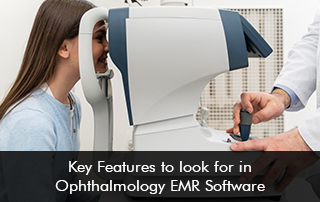Selecting the right EMR system for an ophthalmology practice is crucial for optimizing workflows, improving efficiency, and delivering high-quality patient care. In today’s fast-paced healthcare landscape, Electronic Medical Record (EMR) systems have become vital tools for ophthalmology practices. An Ophthalmology-specific EMR system can streamline workflows, enhance efficiency, and improve patient care. However, not all EMR systems are created equal. It is crucial for ophthalmologists to carefully consider the key features when selecting an EMR system that meets the unique needs of their practice.
In this blog post, we will explore the following key features to look for in an ophthalmology EMR system.
Key Features:
- Ophthalmic-specific templates
- Imaging integration
- Referral management
- Interoperability
- Clinical decision support
Each of these features contributes to streamlining processes, enhancing collaboration, and improving patient outcomes. By carefully evaluating these key features, ophthalmologists can find an EMR system that aligns with their unique needs, leading to improved practice efficiency and exceptional patient care.
Ophthalmic-Specific Templates:
One essential feature to look for in an ophthalmology EMR system is the availability of ophthalmic-specific templates. By using these templates, ophthalmologists can streamline the documentation process, ensuring accurate and comprehensive recording of ophthalmic findings. This feature eliminates the need for manual documentation, saves time, and ensures consistency in data entry.
- Customized templates for various ophthalmic examinations, such as visual acuity, slit-lamp examination, and fundus evaluation.
- Structured format for documenting ophthalmic findings efficiently and accurately.
- Simplifies data entry and ensures consistency in documentation.
Imaging Integration:
A crucial aspect of an ophthalmology EMR system is its ability to integrate with various imaging modalities commonly used in ophthalmic practices.
- Seamless integration with ophthalmic imaging modalities like optical coherence tomography (OCT) and fundus photography.
- Easy access to imaging results within the EMR system.
- Streamlines the review of diagnostic images and eliminates manual image importing.
Referral Management:
Efficient referral management is another crucial feature to consider in an ophthalmology EMR system. Ophthalmologists often need to refer patients to other specialists or healthcare facilities for further evaluation or treatment. This ensures that all relevant patient information is securely shared, enhancing care coordination and improving patient outcomes.
- Tools for generating referral letters and tracking the referral process.
- Seamless communication with other healthcare providers involved in patient care.
- Maintain a referral network for quick and secure exchange of patient information.
Interoperability and Data Exchange:
Interoperability is an essential consideration when selecting an EMR system for ophthalmology practices. The system should be capable of seamlessly exchanging data with other healthcare systems. It allows ophthalmologists to access comprehensive patient information from various sources within the EMR system, facilitating informed decision-making and comprehensive patient care.
- Compatibility with other healthcare systems, including laboratory systems, pharmacy systems, and billing systems.
- Smooth data exchange to avoid duplicate data entry and enhance care coordination.
- Seamless communication between different healthcare providers involved in a patient’s care.
Clinical Decision Support:
Clinical decision support tools are a valuable feature in an ophthalmology EMR system. They help ophthalmologists stay up-to-date with the latest research and best practices, ensuring that they provide high-quality care to their patients. This feature improves patient safety, reduces errors, and enhances overall care quality.
- Integration of clinical decision support tools to assist ophthalmologists in making informed decisions.
- Evidence-based guidelines, alerts, and reminders for adherence to best practices to notify ophthalmologists about important considerations, such as allergies, potential drug interactions, or follow-up appointments.
- Enhances patient safety and quality of care.







